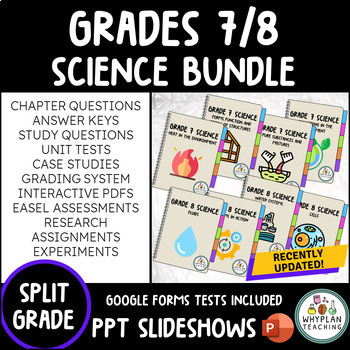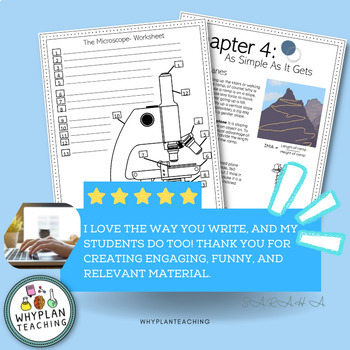2022 Curriculum Grade 7/8 Ontario Science Mega Bundle - 8 Unit Student Workbooks
- Zip
- Easel Assessment
What educators are saying
Products in this Bundle (8)
showing 1-5 of 8 products
Bonus
Also included in
- ✬Enjoy all of our Ontario Grade 8 and Grade 7 Science Units in this bundle!(This bundle includes both French and English science units)Before I describe this resource, I'd like to share my innovation with you; QR codes! This unit has QR codes and embedded links for your/your students' convenience! TPrice $55.62Original Price $81.77Save $26.15
Description
Students will learn a variety of specific and global expectations in grade 7 and 8 Ontario Science Curriculum. Great news, all of my grades 7 and 8 Ontario science chapters have been bundled together, creating the ultimate Intermediate Science Bundle.
I'll get straight to the point. Many students don't enjoy reading textbooks because the content is often very dry and bland. Most books lose student interest. Upon purchasing this teaching resource, you'll notice that this packet is written differently. It's informal, loaded with jokes, and tries to teach students on a personal level.
Moreover, it entices them to try to perform their own inquiry-based independent science experiments at home. I wanted to write it as if I were conversing with your students. It's a short unit(compared to textbook units), but it is filled with embedded links, QR codes, an online version of all chapter questions, unit tests, and independent research. It has everything you need to cover the specific and global expectations of the Ontario science curriculum.
I would consider this resource "low-prep" as there is nothing required of you but to print it. However, there may be some science experiments that require some setup. I've included some chapter quizzes/assignments in PDF and Google Forms. Use these tasks as consolidation assignments or discussion topics in your classroom! The content of this packet is relevant and accurate. It will not impede their understanding!
Fundamental changes in the 2022 curriculum are outlined in pdf. I intend to add extra content to ensure you meet them.
This comprehensive package covers essential science concepts and helps students develop critical thinking and problem-solving skills.
GRADE 7
In Understanding Life Systems Interactions in the Environment, students will learn how to assess the impacts of human activities and technologies on the environment and evaluate ways of controlling these impacts. They'll investigate interactions within the environment and identify factors that affect the balance between different components of an ecosystem. Students will also demonstrate an understanding of interactions between and among biotic and abiotic elements in the environment.
In Understanding Structures and Mechanisms Form and Function, students will analyze personal, social, economic, and environmental factors that must be considered in designing and building structures and devices. They'll create and construct various facilities and investigate the relationship between these structures' design and function and the forces acting on them. Students will also demonstrate an understanding of the relationship between structural forms and the forces that act on and within them.
In Understanding Matter and Energy Pure Substances and Mixtures, students will evaluate the social and environmental impacts of using and disposing of pure substances and mixtures. They'll investigate the properties and applications of pure substances and mixtures and demonstrate an understanding of them, describing these characteristics using particle theory.
In Understanding Earth and Space Systems Heat in the Environment, students will assess the costs and benefits of technologies that reduce heat loss or heat-related environmental impacts. They'll investigate how heat changes substances and describe how heat is transferred. Students will also demonstrate an understanding of heat as a form of energy associated with the movement of particles and essential to many processes within the earth's systems.
This science bundle is a must-have for students looking to understand these critical scientific concepts better.
GRADE 8
In Understanding Life Systems Cells, students in grade 8 will learn how to assess the impact of cell biology on individuals, society, and the environment. They'll investigate the functions and processes of plant and animal cells and demonstrate an understanding of their basic structure, function, and operations.
In Understanding Structures and Mechanisms Systems in Action, students will assess a system's personal, social, and environmental impacts and evaluate improvements to a method and alternative ways of meeting the exact needs. They'll investigate a working system and how its components contribute to its desired function and demonstrate an understanding of different types of systems and the factors that contribute to their safe and efficient operation.
In Understanding Matter and Energy Fluids, students will analyze how the properties of fluids are used in various technologies and assess the impact of these technologies on society and the environment. They'll investigate the properties of liquids and demonstrate an understanding of the properties and uses of fluids.
Finally, in Understanding Earth and Space Systems Water Systems, students will assess the impact of human activities and technologies on the sustainability of water resources. They'll investigate what affects local water quality and demonstrate an understanding of the characteristics of the earth's water and the influence of water systems on a specific region.
This science bundle covers many essential concepts and helps students develop critical thinking and problem-solving skills. It's a valuable resource for grade eight students seeking a deeper understanding of these important scientific topics.
*Note: Independent experiments are going to be added to the resources*
Update: In the process of adding TPT lessons to ALL units. Stay tuned!
Blog ✎ Facebook ✎ Instagram ✎ Pinterest
Have a look!






